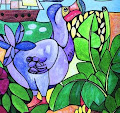 Dear readers, last December in honour of Christmas, I had a string of posts on artists painting Nativity scenes, which I am pleased to say have become a big hit on Google search engines both in images and text. Thank you Google.
Dear readers, last December in honour of Christmas, I had a string of posts on artists painting Nativity scenes, which I am pleased to say have become a big hit on Google search engines both in images and text. Thank you Google.This year round, I thought I would pick the brains of a "know it all" art freak in my family and do another series or at least one post on icons and painting depicting the life of Jesus Christ. The art freak, knowing about my pet peeve against the cavemen's book, said something about "Byzantine art was killed by the Ottoman Turks and arabs"... that did it for me. I started reading up on this particular form of art and artists with the intention of writing at least one little article on Byzantine art. So, this is it.
 Byzantine art was rampant in Greece and surrounding areas from approx 310 AD to approx. 1455 AD. How did such a cultural, powerful economic and military force die off? The invading moslem forces of the Ottoman cavemen did them in, that's how.
Byzantine art was rampant in Greece and surrounding areas from approx 310 AD to approx. 1455 AD. How did such a cultural, powerful economic and military force die off? The invading moslem forces of the Ottoman cavemen did them in, that's how. We must never let history, the horrible parts of it, repeat themselves ever again. Some of us have donned that cloak of "duty" on ourselves and hope to remind people that the moslems, from time memorial, have been destroyers of everything and anything of beauty and intelligence.... and come what may, it must never ever happen again.
A short synopsis of Byzantine art: It is the oldest form of art venerating the birth of Christ, his life and his mother. Byzantine art set the trend to show the new religion Christianity in various painting and icons and this was later followed up by the Italian painters and others who have now become household names.
The thing that saddens me about Byzantine paintings and other art is that many of the paintings which have survived are from anonymous artists and that's a total shame. Such great masterpieces and their descendents have no idea if they have that artistic gene running in their veins. The most credit for popularizing the advent of Christianity should go to the early Christians of the areas now shown as Greece, Syria, Egypt, Iraq and even Iran. Hard to believe, eh?! All these nations used to be Christian, Judea or Zorastrian .. what are they now ?
1) The Byzantine work is easy to identify and is an easy style to adopt... it needs rigid formality of the figures, especially the main figure or figures. You will see that the artists almost always kept the figures to a bare minimum. The main figure took all their focus and they were extra meticulous in painting the symmetrical folds of the figure's clothing and other accessories like sandals on the feet or the halo over the head.
2) Byzantine works often do not have exceptional or skillful design or effort with the backgrounds. The details are minimal and the landscape or trees are like an afterthought to fill up the space.
All you need to do is study in depth about 20 to 30 Byzantine works and you can walk into any musuem in the world and will be able to point out confidently all the pieces belonging to that era.
Byzantine art and artists helped Christianity to gain more popularity and it would have been hard to find a single artist of that period that did not focus his efforts more on Christian themes than on any other subject.
Here's a listing where students of this art form can get more material:




Merry Christmas!
ReplyDelete